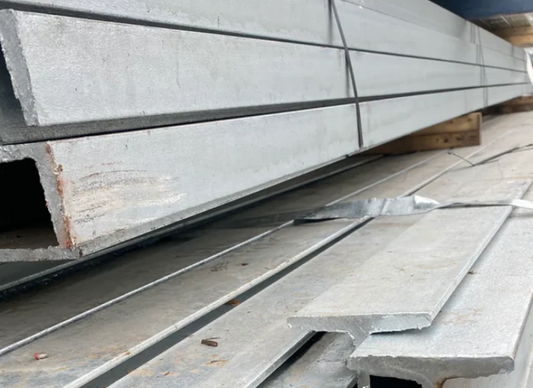Checker plate aluminum has been used for decades in industrial and commercial settings due to its strength, longevity, and safety benefits.
While it may seem like a simple metal surface, there is more to this material than meets the eye. Let's take a closer look at the aluminum checker plate and its many uses.
Why to buy checker plate from austrina steels
A tread plate, also known as a checker plate or diamond plate, is a type of metal stock with a regular pattern or lines on one side for slip resistance. The most common alloy used for aluminum tread plates is 6061, although 5086-H34 and 3003-H231 are also used.
Diamond plates are usually steel, stainless steel, or aluminum. Steel types are normally made by hot rolling, although modern manufacturers also make a raised and pressed diamond design.
The added texture reduces the risk of slipping, making diamond plates a versatile solution for safety in various industrial settings such as stairs, catwalks, walkways, ramps, as well as interior spaces like ambulances and firetrucks due to their non-skid properties that reduce accidents. It's not limited to just industrial applications; it finds use in truck beds and trailer floors too.
Tread plates can also serve as a decorative element, especially the highly polished aluminum types. A diamond plate made of plastic is sold as an interlocking tile system for use in garage floors, trailers, and exercise rooms.
Features That Make Checker Plates Useful
Aluminum plates have become the go-to material for flooring, cladding, ramps, toolboxes, and many more due to the extensive benefits they offer. Some of them are:
- Anti-skid: The raised surface of the checker plate provides traction, making it slip-resistant.
- Anti-corrosion and Rust: Aluminum and galvanized materials protect the checker plate from rust and corrosion in harsh environments.
- Anti-High Temperature and Alkaline: Stainless steel checker plates are resistant to high temperatures and alkaline substances.
- Decorative: The polished aluminum checker plate has an attractive appearance, adding a decorative touch.
- Self-cleaning and Minimized Maintenance: Channel-shaped safety grating, expanded metal grating, and serrated bar steel grating have large holes that allow for self-cleaning and reduced maintenance needs.
- Economical and Easy to Install: Checker plates are one-piece structures that are lightweight, making them easy to install with minimal labor costs.
Uses and Types of Aluminum Checker Plates
Aluminum checker plates come in different patterns and types, each with its own uses.
1. 5-bar aluminum checker plate:
It is the most prevalent type of aluminum checker plate, known for its outstanding anti-skid performance. It finds extensive use in designing thoroughfares within buildings. This variety comes in two types: large 5-bar and small 5-bar, with different pattern lengths and a pattern height of about 0.8 mm.
Arranged in parallel, the five concave-convex patterns have angles ranging from 60 to 80 degrees with each other, providing excellent anti-slip performance.
Here at Austrina Steels, we offer a range of sizes for 5-bar aluminum checker plates, depending on your needs.
|
Aluminum Checker Plate |
1200mm x 2400mm |
AUD 140 |
|
Aluminum Checker Plate |
1200mm x 2400 mm, 1.6mm |
AUD 160 |
|
1200mm x 2400mm |
AUD 180 |
|
|
1200mm x 2400mm, 3mm |
AUD 255 |
|
|
1500mm x 3000mm, 2mm, Alloy 5052 |
AUD 285 |
|
|
Aluminum Checker Plate |
1500mm x 3000mm, 3mm |
AUD 375 |
2. Compass Pattern:
The impact is similar to that of the five-bar aluminum tread plate. It finds application in carriages, non-slip platforms, cold storage floors, anti-slip production workshop floors, and elevator car anti-slip layers. For specific conditions (such as suspension in air or high-corrosion areas prone to rust), it is advisable to utilize 5052 or 6061 aluminum pattern plates.
3. Orange Peel Pattern:
It contains numerous small branches, such as the traditional aluminum plate with an orange peel design and a smaller bug pattern. Its surface displays patterns resembling an orange peel and is primarily utilized in refrigerators, air conditioners, and packaging applications.
4. Spherical Pattern:
It is also known as a hemispherical-patterned aluminum sheet with a small spherical design on its surface, resembling a small pearl. This type of aluminum sheet is frequently employed for outer packaging due to its distinct patterns, which provide significantly greater compressive strength compared to other aluminum tread plates.
5. Lentil Pattern:
It is a popular non-slip aluminum plate variety known for its effective anti-slip properties. Its uses are comparable to those of the compass-patterned aluminum plate and the 5-bar aluminum plate.
6. Aluminum Diamond Plate:
It is typical in packaging pipelines or outer package boxes. The form resembles a parallelogram, similar to that of a prism. The texture also consists of both large and small prisms. The usual pattern thickness ranges from 0.1mm to 1.0mm.
7. Other Patterns:
Some additional unique designs available for checker plates are undulating patterns, aluminum tiles, woven rattan styles, three-dimensional triangles, striped patterns, river pebbles, and butterfly motifs.
When purchasing aluminum checkered plates, it's important to consider the pattern formation rate and variations in pattern height.
Conclusion
Overall, checker plate aluminum brings durability, functionality, and safety benefits to a wide range of settings. Its diamond plate pattern provides traction while allowing for ease of movement and cleaning.
Though simple in form, checker plate has proven to be a highly versatile material for decades thanks to aluminum's qualities.




